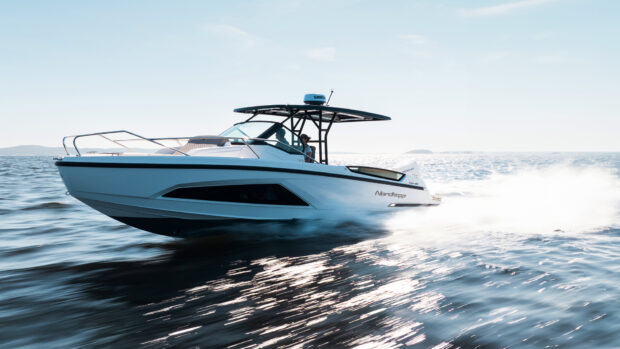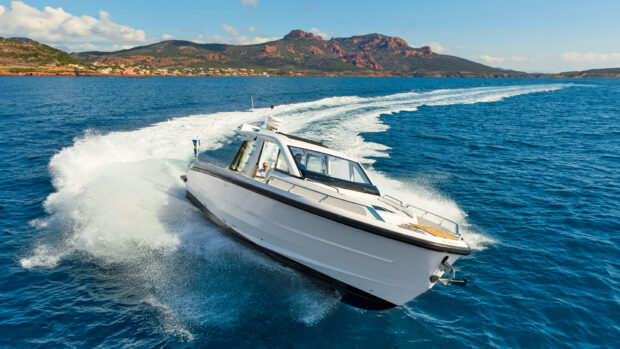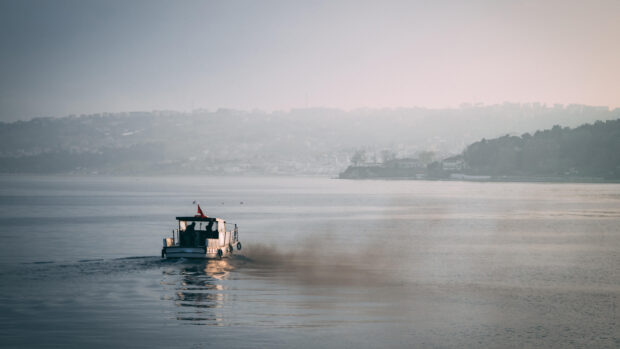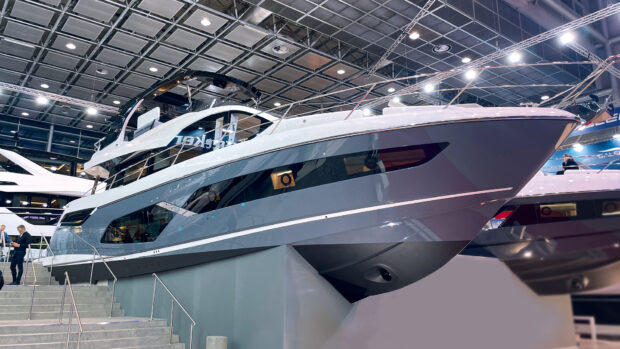Sacrificing a full-beam owner’s cabin for bigger, better guest cabins makes sense for those who like to cruise with lots of friend. But is it a price worth paying?
How many friends do you have? No doubt if you had a boat as glamorous as this new Azimut 47, you would find yourself with at least two couples who wanted to be your very best friends!
No question then, that three generous cabins, which the 47 offers, can be a great benefit -you won’t find any narrow bunk beds here.
The designers have even managed to keep the galley downstairs making way for a separate raised dinette in the saloon – a feature that no other boat in its class can offer.
Factor in Azimut’s reputation for cutting-edge style, top-notch build quality, and the support of one of the UK’s largest boat dealers (now that Peters Opal arc selling them), and this 47ft flybridge contender seems to have it all sewn up. So where’s the catch?
Down below on the Azimut 47
Around this size and price, the biggest dilemma to ponder is selfishness – are you prepared to sacrifice the decadence of a spacious full-beam owner’s cabin (available on other boats for similar money) so you can treat your second pair of guests to a cabin without bunk beds?
It’s not just the convenience of independent berths and extra floor space we’re talking about here these are exceptional guest cabins.
Large hull-side windows transform the feeling of light and space inside, and provide a wonderful sense of connection with the water.
At 6ft 4in (1.93m) long and around 29in (740mm) wide, the berths are a good size, and although the beds in the port cabin are fixed, the two in the starboard cabin can slide together to form a 4ft 10in-wide (1.48m) double, which is another priceless bonus.

The berth in the owner’s cabin lifts to reveal a locker. There are drawers underneath the bed.
Adjustable reading lights, opening ports, stainless steel door thresholds, and easily accessible drawers under the berths, instead of awkward loose panels hidden under the cushions – the Azimut 47 sports plenty of useful detailing, too.Inevitably, the forward owner’s cabin layout is the archetypal centreline double, but again it’s the detail that impresses.
Where normally only the back half of the berth lifts (if at all), the whole of the berth base rises on gas struts to give access to two storage bays.
Fitting three pairs of oblong portholes makes a surprising difference to the natural light in the cabins – one or two is the norm.

Owner’s and guest heads are almost identical.
Other refinements include the cedar-lined wardrobes and drawers, duplicate light switches at the bedhead, rubber seals around the doors to reduce noise transmission, and a full-length mirror that cantilevers out from inside the wardrobe.
One neat trick is combining the usual separate eye-level locker doors into one, making it eaisier to rummage around and find things (as well as being cheaper to build).
If you find yourself with more friends on board than the usual four, it is possible to squeeze a total of nine adults into beds.

Starboard cabin berth can be arranged as double or singles.
Around £2,900 will buy you the optional sofabed that pulls out from beneath the saloon seating, and another £13,300 secs the lazarette transformed into a crew cabin, complete with mini-heads and a shower.
Sure, it’s tight down here, but the berth is still adult size and there’s enough stowage for occasional singletons. If you plan any long cruises, it’s worth remembering that this crew cabin becomes the surrogate lazarette because the lengthy engineroom precludes the Azimut 47 from also having a separate large lazarette, as some other boats in this class do.
Italian seatfest
Wander into the saloon and there seems to be enough seating to host a Barry Manilow concert.
The logical amongst us would ask: ‘why include a second raised dinette?’ Especially when there is already a comfortable seating area for six, complete with an electrically adjustable hi-lo folding table, suitable for everything from drinks and nibbles to full-on dining, plus two more comfy seats opposite.
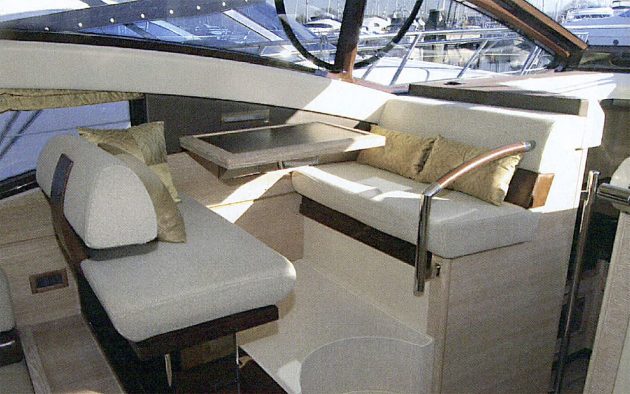
Raised dinette sports an adjustable table.
Well, sit at the raised dinette and you’ll immediately know why.
Four adults would find this spot cosy, but it is the perfect place for breakfast croissants and sipping cappuccino from Azimut’s china cups (part of the package – this is an Italian boat, after all), or just watching the world whizz by when it’s too cool or damp outside.
A strapping but beautifully engineered sliding stainless steel arm supports the table, which doubles in size in its unfolded state.
This area can also be used as a useful navigation table.
With the sofabed and a sub-woofer gobbling all the space under the main seating, no eyelevel lockers, and clear spaces beneath the dinette seats and the helm seat, saloon stowage is very limited – countertops aside, the only free area is the solitary drawer under the port seats.

Saloon stowage is limited. One option is to replace the port seating with a furniture unit.
Given the abundance of good seating, I’d definitely opt for the optional £2,770 furniture unit that can replace the port-side seating.
Combining three cabins and two ensuite heads with a lower galley is almost unheard of in this size of boat.
This feat inevitably requires some compromise, and as with the other likeminded galley-down boats in this class, the galley is okay but can’t work miracles.

Note the useful vertical handrail in the spacious galley.
The drawer count is fine – two wide ones plus two dedicated to cutlery – and likewise the deep sink and spacious drainer work well.
The hob benefits from adjustable fiddles to secure wayward pots and pans, plus an opening port directly behind the hob.
However, the usable countertop is limited to a single small area, and with the dishwasher and Azimut’s slide-out bins in place, there are no spare lower lockers.
As impressive as these colour-coded bins are, swapping them for low-rent plastic bags would free up the big corner locker, and ditching the dishwasher would provide another.
Chopping-board covers for the sink and cooker would also improve the countertop situation.
Seating aside, the thing that struck me most about the Azimut 47 was the feeling of opulence.
There are tangible elements, such as the fine finish on the sturdy oak joinery and the size
of the leather-bound stainless steel handrails.
Likewise, the exemplary moulding quality contributes, as do the precisely fashioned edge-bound carpets.
But somehow the Azimut 47 seems to add up to more than the sum of its parts.
You know how, when you spot two almost identically dressed women at a party, and without any real evidence somehow understand that one spent £300 on her outfit and the other £3,000?
Well, the Azimut 47 feels like the three-grand lady.
Driving the Azimut 47
Yet again, Azimut have come up with a hull/engine/propeller mix that performs exceptionally well at higher speeds.
Weighing in at 16.2 tonnes light, the voluminous Azimut 47 is only slightly smaller and lighter than its 50ft counterparts.
Yet those rivals need the next engine size up – the 675-715hp D 12 Volvos – to achieve the 32.3-knot top speed of the 47 with its 575hp CAT C9s.
Only the extraordinary Scaline T5O beats the Azimut 47 here, achieving 33.8 knots with 575hp D9 Volvos.
Consequently, the 47 achieves 0.73mpg at 32.3 knots against the Pairline Phantom 50 and Princess 50’s O.56mpg at the same speed.
Interestingly just like the T5O, the tables are turned lower down and around 22 knots the two British boats are achieving 0.84mpg against the Italian boat’s 0.79mpg.
The upshot is that, unless rough conditions dictate otherwise, you may as well cruise at the Azimut 47’s most efficient speed of 26.5 knots, which should yield 0.83mpg and a 292-mile range.
This fits well with the 47’s behaviour: I felt it was happiest cruising at higher speeds when the trim drops slightly and it finds a groove.
Piloting the Azimut 47 is akin to driving a luxury 4X4. Going from the 47 to a Princess 50 is like going from a BMW 5-series into a Lexus RX400.
Where the Princess is almost implausibly precise and speedy to steer for a 5O-footer, the Azimut 47 is languid and its turning circle comparatively large.
How you feel about this comparative laziness will depend on your driving style.
Even in big flybridge boats, I prefer swift steering because in rough conditions I like to steer around the worst lumps.
Others prefer to simply slow down to smooth the ride. The Azimut 47’s lack of responsiveness was even more exaggerated at the flybridge helm.

The big sunbed has extensive storage areas underneath.
Up top the steering felt soggy and imprecise, whereas down below the initial response to the wheel was sharper.
This abnormality will doubtless disappear, so the steering on production models should improve too.
Whatever the outcome, there’s no excuse for the interminable ten turns lock-to-lock with adjustable power steering – surely this could be reduced to three or four?
The boat’s ‘suspension’ feels different too. Although the builder’s figures suggest otherwise, the Azimut 47 feels heavier than the Princess 50 and it tends to lope its way through the waves rather than gallop over the top.
As long as its bow stays immersed, the ride is fine and it rarely slams, although ultimately its high-speed ride did not feel quite as smooth as the outstanding Princess 50, which I drove at 24 knots into a steep 3-4ft head sea with no great discomfort.
Down below, the usefully large dash may appear intrusively deep but Azimut have got their sight lines spot on, and with the 47 trimming between 4.5 and 6 degrees under way the view forward was fine.

Sliding helm seat could take two, but the central wheel means it is better as a large comfy single.
The helmsman’s lot is generally good with an adjustable seat and a tilting wheel helping short and tall alike.
Upstairs, helmsmen benefit from a driving position sited on the same side as the flybridge steps, so reversing into a typical Med mooring is far easier because the driver can eyeball the bathing platform through the flybridge hatch.
As you step onto the flybridge, there’s a low point of 18in (460mm) immediately to your left, so an extra handrail on the back of the helm seat would be a useful safety feature.
On deck, there was only one significant detail that I took exception to – the flybridge table.

A lower flybridge table would make dining up top much easier.
It’s small and fixed quite high, making it impossible to use for alfresco dining, a real wasted opportunity.
Something more like the Fairline Phantom 48’s excellent, large hi-lo table (in classy teak, of course) would transform what is elsewhere an excellent, sociable flybridge.
Otherwise it was business as usual on deck, with pluses such as Azimut’s excellent stern mooring gear set-up, safe and easy access onto the side decks, and the removable central cockpit seat cushions, which provide more surefooted access onto the passerelle.
Engineering and construction
One of Azimut’s most laudable qualities is their easy-going attitude to spending money.
To them, smaller boats do not mean smaller budgets.
Consequently, many of the commendable things you find in their 70ft-plus boats are also in evidence here.
Non-slip steps guide you into the engineroom, and here you find a string of details designed to make your life easier: an invaluable strip-light on a long wandering lead, a freshwater hose with a trigger gun, and remote header tanks.
Other niceties include the drain cock and the sight gauge on the fuel tanks, alongside interchangeable fuel filters with their clear, easily checked bowls.
One rare and outstanding feature is the emergency bilge pump system.

Azimut have pulled a bit of a flanker with this boat.
This comprises a diverter valve, which allows the port engine to serve as a massive pump in a crisis, drawing water directly from the bilge (instead of the raw-water strainer) and ejecting it through the exhaust system.
In the event of a major hull rupture, your normal bilge pumps would be useless, but an 8.8-litre diesel spinning at 2,500rpm could well keep you afloat.
The Azimut 47 also benefits from fully cored, resin-infused, vacuum-bag hull construction and the visible quality of the deck and internal mouldings is as good as any I have seen.
Of course, most good boats have small areas where they excel, but in general you won’t find a boat in this class that leaves the Azimut 47 behind in any crucial area, either down below in the engineroom or more visibly above decks or around the accommodation.
Azimut 47 verdict
Azimut have pulled a bit of a flanker with this boat.
It may say ’47’ on the box, and even genuinely be only a few inches longer than its name suggests, but in practice Azimut have successfully incorporated (notice I didn’t say ‘squeezed’) a very similar amount of usable accommodation and deck space into its voluminous form as its 50ft brethren.
Stir in its elevated build and engineering quality, plus its fine practical detailing, and immediately this Azimut 47 becomes a serious competitor for slightly longer rivals.
It certainly justifies what might otherwise be considered an elevated price for a boat of this size.
Once in the 50ft arena. the Azimut 47’s fight is far from over.
Its obvious 50ft combatants from Princess, Fairline and Sealine all have notable pros and cons to offer, many of them not easily traded or balanced.
How do you weigh the value of a separate lazarette against the enjoyable extravagance of the 47’s second raised dinette, and so on?
And how do you feel about the Azimut 47’s languid handling, which all the outstandingly manoeuvrable British boats outdo?
Is this a fair trade for the impressive high-speed fuel efficiency? Ultimately, I reckon the deciding factor will be selfishness.
Do you love your guests enough to sacrifice the spacious decadence of a full-beam owner’s cabin in order to give them what are unquestionably the two best guest cabins of the bunch?
And suppose you aren’t prepared to make that sacrifice and they come on board your new tri-cabin 50-footer clutching this article – how are you going to look them in the eye?
First published in the May 2007 issue of MBY.
Pros
- Opulent build quality
- Class-best guest cabins
- Generous flybridge seating
- High-speed fuel efficiency
- Secondary raised dinette
- Windows and light in cabins
- Potential to sleep nine
- Sensible engineering details
- Twin/double berth choice
Cons
- Scant storage in saloon
- Small fixed flybridge table
- Galley stowage & countertop
Details
Price from : £526,724 inc UK VAT (twin 575hp)
Price as tested: £627,000 inc UK VAT (twin 575hp)
Overall length: 47ft 5in (14.46m)
Hull length: 46ft 11in (14.30m) ex pulpit & platform
Beam: 14ft 10in (4.52m)
Displacement: 16.2 tonnes light, 18.5 tonnes loaded (loaded = light + 100% fuel & water)
Draught: 4ft 1in (1.24m)
Air draught: 15ft 9in (4.80m) MBY estimate
Fuel capacity: 440 imp gal (2,000 litres)
Water capacity: 130 imp gal (590 litres)
RCD category: B (for 10 people)
Designers: Stefano Righini & Carlo Galeazzi



